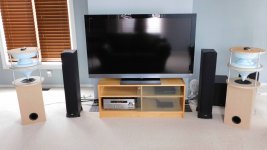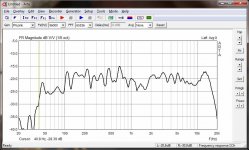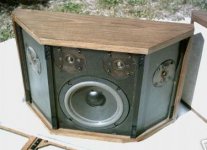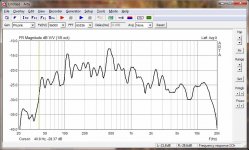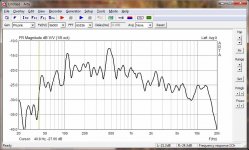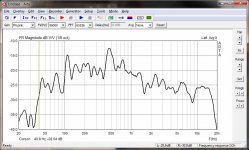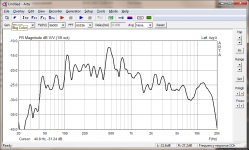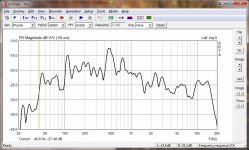I've been working on a pair of Omni's. I'm looking for a different listening experience that is closer to the way real natural instruments project sound and use the room. I am willing to post pictures, and test results to share what works or doesn't, hoping for some insight and suggestions to improve it.
The starting point is this simple 2way setup. There were initial problems with them, but I'm enjoying them now, wanting more improvements. I'll post the those issues and my solutions up to where I am now.
Index to versions:
V1 : starting point, LR4 XO, soft dome tweeter with reflector, 32L BR woofer
V2 : circular waveguide with compression driver, 32L ABC woofer, new cones
http://www.diyaudio.com/forums/multi-way/303941-omnidirectional-work-progress-4.html#post5000878
V3 : circular waveguide, 16L BR woofer, new cones
http://www.diyaudio.com/forums/multi-way/303941-omnidirectional-work-progress-10.html#post5051183
V4 : circular waveguide, 16L BR woofer, same cones, new outer shell to reduce diffraction
http://www.diyaudio.com/forums/multi-way/303941-omnidirectional-work-progress-14.html#post5118639
V5 : new 16L sealed chamber, new discs and cones, added notch filters, same drivers as previous, using all previous lessons learned OmniDirectional - work in progress
The starting point is this simple 2way setup. There were initial problems with them, but I'm enjoying them now, wanting more improvements. I'll post the those issues and my solutions up to where I am now.
Index to versions:
V1 : starting point, LR4 XO, soft dome tweeter with reflector, 32L BR woofer
V2 : circular waveguide with compression driver, 32L ABC woofer, new cones
http://www.diyaudio.com/forums/multi-way/303941-omnidirectional-work-progress-4.html#post5000878
V3 : circular waveguide, 16L BR woofer, new cones
http://www.diyaudio.com/forums/multi-way/303941-omnidirectional-work-progress-10.html#post5051183
V4 : circular waveguide, 16L BR woofer, same cones, new outer shell to reduce diffraction
http://www.diyaudio.com/forums/multi-way/303941-omnidirectional-work-progress-14.html#post5118639
V5 : new 16L sealed chamber, new discs and cones, added notch filters, same drivers as previous, using all previous lessons learned OmniDirectional - work in progress
Attachments
Last edited:
Drivers and CrossOvers
The XO is an 2 way LR4@1.8KHz + Zobel comp. connected to a Silverflute W20RC3808 (200mm woofer) and a Dayton DC28F-8 (28mm tweeter). These sound OK and are suitable for my sandbox.
First issue. The LR4 is constant amplitude but not constant power. So I have a -3db dip at 1.8Khz. Not a big deal but it will show up in all freq resp curves until I fix it.
The XO is an 2 way LR4@1.8KHz + Zobel comp. connected to a Silverflute W20RC3808 (200mm woofer) and a Dayton DC28F-8 (28mm tweeter). These sound OK and are suitable for my sandbox.
First issue. The LR4 is constant amplitude but not constant power. So I have a -3db dip at 1.8Khz. Not a big deal but it will show up in all freq resp curves until I fix it.
Attachments
Bass reflex cabinet issues
I used HornResp to determine the cabinet volume and tuning port size. I tried to "stretch" things a bit and get fc=40Hz from a SilverFlute 8". It came up with 32L and 75mmx150mm pipe. The mfg parameters are off a bit, as I discovered later when searching for test results, but that is not the problem here.
I made the cabinet with internal ring bracing but mounted the woofer at one end so the back of the woofer saw the entire length of the cabinet. The bracing (I think) made it look like a back loaded horn and I got numerous resonances and possible standing waves that no amount of polyester fill could fix (see "before" images).
The cabinet was internally reduced to 16L via new partition and a new 25mmx140mm pipe installed. There are no "ring braces" in this new chamber and the response is pretty much what Horn Resp predicts and it extends out to 1.8KHz and down to 60Hz (when the port resp is included). The high freq tail is due to tweeter bleed through (forgot to disconnect it, like the before image).
I used HornResp to determine the cabinet volume and tuning port size. I tried to "stretch" things a bit and get fc=40Hz from a SilverFlute 8". It came up with 32L and 75mmx150mm pipe. The mfg parameters are off a bit, as I discovered later when searching for test results, but that is not the problem here.
I made the cabinet with internal ring bracing but mounted the woofer at one end so the back of the woofer saw the entire length of the cabinet. The bracing (I think) made it look like a back loaded horn and I got numerous resonances and possible standing waves that no amount of polyester fill could fix (see "before" images).
The cabinet was internally reduced to 16L via new partition and a new 25mmx140mm pipe installed. There are no "ring braces" in this new chamber and the response is pretty much what Horn Resp predicts and it extends out to 1.8KHz and down to 60Hz (when the port resp is included). The high freq tail is due to tweeter bleed through (forgot to disconnect it, like the before image).
Attachments
-
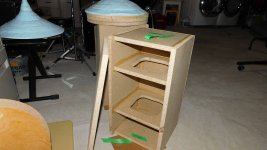 Before 32L DSCN1806 reduced.jpg469.9 KB · Views: 1,643
Before 32L DSCN1806 reduced.jpg469.9 KB · Views: 1,643 -
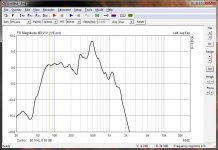 Before 32L woofer amp-25db 5 cm above woofer.jpg95.2 KB · Views: 1,533
Before 32L woofer amp-25db 5 cm above woofer.jpg95.2 KB · Views: 1,533 -
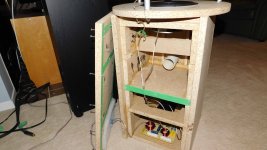 After 16L DSCN1832 reduced.jpg587.6 KB · Views: 1,551
After 16L DSCN1832 reduced.jpg587.6 KB · Views: 1,551 -
 After 16L DSCN1833 reduced.jpg497.7 KB · Views: 627
After 16L DSCN1833 reduced.jpg497.7 KB · Views: 627 -
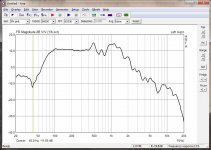 After 16L woofer with 5x14cm port over woofer with cones on.jpg96.4 KB · Views: 596
After 16L woofer with 5x14cm port over woofer with cones on.jpg96.4 KB · Views: 596
Is that lower woofer reflector cone necessary?
When I looked at various omni designs, some used a lower reflector cone (Deuval) and some didn't (Linkwitz). So I tested with and without cones to see for myself. In my case the woofer is always below the listening level. In my measurement graphs , the room acoustics are included so you'll see a bumpy curve from reflections.
Turns out that below 1Khz for a 200mm (8") it does not seem to make much difference. Regardless, I'm keeping mine as a "visual aid" and to support the upper cones. The woofer reflector is also not sensitive to surface shape or smoothness as I tried rough->refined->smoothed out and saw virtually no difference as I tried to make a better surface. Since my measurements are at 1m you can see the effect of the reflex port extending bass response.
Notice what happens to the high freq response when the upper reflector is in place. That's the next issue to deal with.
When I looked at various omni designs, some used a lower reflector cone (Deuval) and some didn't (Linkwitz). So I tested with and without cones to see for myself. In my case the woofer is always below the listening level. In my measurement graphs , the room acoustics are included so you'll see a bumpy curve from reflections.
Turns out that below 1Khz for a 200mm (8") it does not seem to make much difference. Regardless, I'm keeping mine as a "visual aid" and to support the upper cones. The woofer reflector is also not sensitive to surface shape or smoothness as I tried rough->refined->smoothed out and saw virtually no difference as I tried to make a better surface. Since my measurements are at 1m you can see the effect of the reflex port extending bass response.
Notice what happens to the high freq response when the upper reflector is in place. That's the next issue to deal with.
Attachments
The high freq section needs work.
I have 2 reflectors for the tweeter in an attempt to make a hybrid waveguide and reflector. In playing with a ripple tank simulator, it looked like the exit path needed to be controlled to prevent different path lengths from the tweeter and destructive interference. It seemed to work for an ideal point source, which sadly does not seem to apply to a 28mm dome tweeter.
The top "doughnut" was removed entirely as it caused interference between the upper doughnut and middle cone. The sound was distorted and no amount of frequency equalization could fix it. Just did not work.
With only a single middle reflector in place it seems to work OK but not great. It's usable with equalization and boosting. There are two issues 1) uneven response and 2) overall attenuation.
The overall attenuation (I think) is a result of increasing the projection cone angle from from 120deg (direct tweeter) to 360deg (cone) which lowers the pressure by approx 1/3 or 10*log(0.33)=~-5db. The tweeter is spec'd at -2db less efficient than the woofer. There is also absorption factor (0.15) from polystyrene or additional -1.0db. The total damage is -8db reduction in virtually everything from the tweeter w.r.t woofer levels and you can see it in the graphs and hear it. I need a higher efficiency tweeter (compression driver + waveguide) or active XO with seperate amps. I chose (placed the order) for the compression driver and conical waveguide which should arrive this week.
I have 2 reflectors for the tweeter in an attempt to make a hybrid waveguide and reflector. In playing with a ripple tank simulator, it looked like the exit path needed to be controlled to prevent different path lengths from the tweeter and destructive interference. It seemed to work for an ideal point source, which sadly does not seem to apply to a 28mm dome tweeter.
The top "doughnut" was removed entirely as it caused interference between the upper doughnut and middle cone. The sound was distorted and no amount of frequency equalization could fix it. Just did not work.
With only a single middle reflector in place it seems to work OK but not great. It's usable with equalization and boosting. There are two issues 1) uneven response and 2) overall attenuation.
The overall attenuation (I think) is a result of increasing the projection cone angle from from 120deg (direct tweeter) to 360deg (cone) which lowers the pressure by approx 1/3 or 10*log(0.33)=~-5db. The tweeter is spec'd at -2db less efficient than the woofer. There is also absorption factor (0.15) from polystyrene or additional -1.0db. The total damage is -8db reduction in virtually everything from the tweeter w.r.t woofer levels and you can see it in the graphs and hear it. I need a higher efficiency tweeter (compression driver + waveguide) or active XO with seperate amps. I chose (placed the order) for the compression driver and conical waveguide which should arrive this week.
Attachments
Always interesting to see another omni build, considering a cheapy LX mini type build myself.
Any thoughts on the sound quality now?
Any thoughts on the sound quality now?
At this time the dome tweeter is still installed. So I boost the HF using an equalizer as a temporary fix.Always interesting to see another omni build, considering a cheapy LX mini type build myself.
Any thoughts on the sound quality now?
They are very enjoyable to listen to, I've spent the last week trying different program material. I think they are especially strong with acoustic instruments (guitar, piano, string quartets, orchestra) mostly because these instruments primary freq are <2KHz and the music pace and dynamic range allows my ears to pickup the room reflections so the speakers tend to disappear and the sound is spacious and enveloping like an instrument in the room.
They are not so good (at this time) for music like hard rock or high intensity low dynamic range (everything mastered at one high wall of music level). I haven't figured out if this problem is room reflections or a weak HF section or sensitivity or distortion. I'll post results when the waveguides are installed.
Don, a fascinating project, and well documented. 🙂
I had a read around, and the prognosis for omnidirectional doesn't look good to me: Sonab OA5 mkII
I seriously wonder whether wall-mounting might not work better than floor mounting. It kind of ends up in the same place with adjacent boundaries. You possibly know about the Allison effect with the first reflection from the nearest boundary which creates a suckout.
I do appreciate the secondary sound of the room as an important part of the sound of a loudspeaker. Especially if you are not tied to a sweet spot for listening.
BTW, to correct the power hole in LR4, you just overlap the bass and tweeter more.
I had a read around, and the prognosis for omnidirectional doesn't look good to me: Sonab OA5 mkII
I seriously wonder whether wall-mounting might not work better than floor mounting. It kind of ends up in the same place with adjacent boundaries. You possibly know about the Allison effect with the first reflection from the nearest boundary which creates a suckout.
I do appreciate the secondary sound of the room as an important part of the sound of a loudspeaker. Especially if you are not tied to a sweet spot for listening.
BTW, to correct the power hole in LR4, you just overlap the bass and tweeter more.
Attachments
I did. See earlier in the thread. Is a lower reflector needed?try it without diffusors, just try, why not?
Yes, the -3db fix is easy. I'll add a capacitor to the HF filter and shift the response left. But that has to wait unit after I install the compression drivers and waveguides. Maybe more changes coming.Don, a fascinating project, and well documented. 🙂
I had a read around, and the prognosis for omnidirectional doesn't look good to me: Sonab OA5 mkII
I seriously wonder whether wall-mounting might not work better than floor mounting. It kind of ends up in the same place with adjacent boundaries. You possibly know about the Allison effect with the first reflection from the nearest boundary which creates a suckout.
I do appreciate the secondary sound of the room as an important part of the sound of a loudspeaker. Especially if you are not tied to a sweet spot for listening.
BTW, to correct the power hole in LR4, you just overlap the bass and tweeter more.
I will certainly try them in different room positions, but I expect that they need to be away from the wall (currently 1.3m) to get a reflection (7.5ms from incident). If they were positioned too close the reflection is nearly coincident with initial wave. This is like having the musician right against the concert wall to control the reflection. My reference baseline is an actual acoustic guitar played in the spot where the speaker currently stands so I can compare the two.
For such a low crossover frequency it is not needed.I did. See earlier in the thread. Is a lower reflector needed?
Good and inspiring work, by the way!
BTW, to correct the power hole in LR4, you just overlap the bass and tweeter more.[/QUOTE]
Hi, hope you don't mine me butting in here. I think I have this problem with my fullrange FAST set up, but I thought this xover was supposed to sum flat
Hi, hope you don't mine me butting in here. I think I have this problem with my fullrange FAST set up, but I thought this xover was supposed to sum flat
Never a problem. I did simulate my design with spice and happily looked at the -6db amplitudes at Fc , overall flatness and didn't give it another thought. Then I measured the actual acoustic output, rechecked everything, and then it made total sense why my power was down -3db.
Thanks. Same here, only found it after EQing LF and then measuring. I shall follow this thread with interest....
LR4 is a flat frequency response solution with a -6dB crossover. The power hole comes from the way you get a null above and below axis. For a 3kHz crossover, you tune the bass to about 2kHz, and the tweeter to about 5kHz.
BW3 is a constant power solution with a -3dB crossover. It also seems to give a flat impedance if you don't correct for bafflestep, which means wall mounting. For a 3kHz crossover, bass and treble filters both tune to 3kHz on component values.
I'm winging it a bit here, but 90 degrees can mean phase alignment or directional alignment. A FAST usually aligns the bass sideways and the tweeter forwards. So you should design for a constant power +3dB crossover peak on a flat baffle and good phase alignment.
Then when you face the bass sideways, on either polarity because BW3 doesn't care, the power stays flat and the +3dB peak goes away. In practise, BW3 works the drivers harder at crossover. It's worth experimenting with polarity IMO. They do different things.
Well, that's my theory. BW3 is quite difficult in practise. Some drivers play nicely, other don't.
BW3 is a constant power solution with a -3dB crossover. It also seems to give a flat impedance if you don't correct for bafflestep, which means wall mounting. For a 3kHz crossover, bass and treble filters both tune to 3kHz on component values.
I'm winging it a bit here, but 90 degrees can mean phase alignment or directional alignment. A FAST usually aligns the bass sideways and the tweeter forwards. So you should design for a constant power +3dB crossover peak on a flat baffle and good phase alignment.
Then when you face the bass sideways, on either polarity because BW3 doesn't care, the power stays flat and the +3dB peak goes away. In practise, BW3 works the drivers harder at crossover. It's worth experimenting with polarity IMO. They do different things.
Well, that's my theory. BW3 is quite difficult in practise. Some drivers play nicely, other don't.
Last edited:
Thanks. That's really interesting. Guess I should have mentioned, it's open baffle too and U frame subs so 90 degree angling is not and option. Lots to mull over though
BTW, Don, here's a Visaton SC5 tweeter that I thought could make a good supertweeter above 5kHz. Because most of the 1" and bigger tweeters have dispersion problems at the top end.
SC 5 - 8 Ohm
I really have no idea how it sounds, but the regular mylar sound, you'd guess. And I don't think the ear is very discriminating above 10kHz anyway.
A 0.5" dome ought to have very good and flat power response up to the limit of audibility. Cheap enough to use several, if you wanted too. Audax make one like this too.
SC 5 - 8 Ohm
I really have no idea how it sounds, but the regular mylar sound, you'd guess. And I don't think the ear is very discriminating above 10kHz anyway.
A 0.5" dome ought to have very good and flat power response up to the limit of audibility. Cheap enough to use several, if you wanted too. Audax make one like this too.
But is it OmniDirectional?
The shape of my omni sandbox is not ideal. It has a rectangular base, large reflector discs, it's bass ported, and uses posts to support the discs. There's the potential for lots of baffle diffraction and unintentional reflections.
So I fixed the measurement mic w.r.t the room, and rotated the speaker -120, -60, 0, +60, and +120. In hindsight I should have added +180, oh well. The room acoustics are the same w.r.t mic and whats left is the radiation pattern from the speaker at different polar angles. Measurements are 1m out at center disc height. I still have my soft dome tweeters installed so the HF is suffering, and the XO still has the -3db dip from LR4@1800Hz . However the response is very close for all angles.
P.S. I've always had a problem with using the term "omnidirectional" to describe an "omnipolar" response but that seems to be the norm. Once I get the polar stuff working I'll try making this a hemispherical radiator.
The shape of my omni sandbox is not ideal. It has a rectangular base, large reflector discs, it's bass ported, and uses posts to support the discs. There's the potential for lots of baffle diffraction and unintentional reflections.
So I fixed the measurement mic w.r.t the room, and rotated the speaker -120, -60, 0, +60, and +120. In hindsight I should have added +180, oh well. The room acoustics are the same w.r.t mic and whats left is the radiation pattern from the speaker at different polar angles. Measurements are 1m out at center disc height. I still have my soft dome tweeters installed so the HF is suffering, and the XO still has the -3db dip from LR4@1800Hz . However the response is very close for all angles.
P.S. I've always had a problem with using the term "omnidirectional" to describe an "omnipolar" response but that seems to be the norm. Once I get the polar stuff working I'll try making this a hemispherical radiator.
Attachments
- Home
- Loudspeakers
- Multi-Way
- OmniDirectional - work in progress
